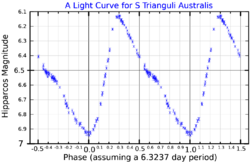Astronomy:S Trianguli Australis
From HandWiki
Short description: Variable star in the constellation Triangulum Australe
| Observation data Equinox J2000.0]] (ICRS) | |
|---|---|
| Constellation | Triangulum Australe |
| Right ascension | 16h 01m 10.71590s[2] |
| Declination | −63° 46′ 35.5324″[2] |
| Apparent magnitude (V) | 6.41[3] (5.95 – 6.81)[4] |
| Characteristics | |
| Spectral type | F8 II[5] |
| B−V color index | 0.567±0.020[6] |
| Variable type | δ Cep[7] |
| Astrometry | |
| Radial velocity (Rv) | 2.2±1.3[8] km/s |
| Proper motion (μ) | RA: −2.244[2] mas/yr Dec.: −2.804[2] mas/yr |
| Parallax (π) | 1.0753 ± 0.0301[2] mas |
| Distance | 3,030 ± 80 ly (930 ± 30 pc) |
| Absolute magnitude (MV) | −3.53[9] |
| Details | |
| Mass | 2.8[10] M☉ |
| Radius | 39.2[10] R☉ |
| Surface gravity (log g) | 2.1±0.1[3] cgs |
| Temperature | 5,976±67[3] K |
| Metallicity [Fe/H] | 0.12±0.05[3] dex |
| Other designations | |
| Database references | |
| SIMBAD | data |
S Trianguli Australis is a yellow-white hued variable star in the constellation Triangulum Australe. It is a dim star near the lower limit of visibility with the naked eye, having a typical apparent visual magnitude of 6.41.[3] Based upon an annual parallax shift of 1.08 mas,[2] it is located 3,030 light years from the Earth.
A Classical Cepheid variable, its apparent magnitude ranges from 5.95 to 6.81 over 6.32344 days.[4] It is a bright giant with a nominal stellar classification of F8 II,[5] that pulsates between spectral types F6II-G2.[4] The star has 2.8 times the mass of the Sun and 39.2 times the Sun's radius.[10] It is losing mass at the estimated rate of 2.8×10−10 M☉·yr−1.[9]
References
- ↑ "Light Curve". ESA. https://www.cosmos.esa.int/web/hipparcos/java-tools/light-curve.
- ↑ 2.0 2.1 2.2 2.3 2.4 2.5 Brown, A. G. A. (August 2018). "Gaia Data Release 2: Summary of the contents and survey properties". Astronomy & Astrophysics 616: A1. doi:10.1051/0004-6361/201833051. Bibcode: 2018A&A...616A...1G.
- ↑ 3.0 3.1 3.2 3.3 3.4 Soubiran, Caroline et al. (2016). "The PASTEL catalogue: 2016 version". Astronomy & Astrophysics 591 (118): A118. doi:10.1051/0004-6361/201628497. Bibcode: 2016A&A...591A.118S.
- ↑ 4.0 4.1 4.2 Watson, Christopher (4 January 2010). "S Trianguli Australis". American Association of Variable Star Observers. http://www.aavso.org/vsx/index.php?view=detail.top&oid=36666. Retrieved 23 May 2015.
- ↑ 5.0 5.1 Houk, Nancy; Cowley, A. P. (1979). "Michigan catalogue of two-dimensional spectral types for the HD stars". Ann Arbor: Dept. Of Astronomy (Ann Arbor, Michigan) 1. Bibcode: 1978mcts.book.....H.
- ↑ Anderson, E.; Francis, Ch. (2012), "XHIP: An extended hipparcos compilation", Astronomy Letters 38 (5): 331, doi:10.1134/S1063773712050015, Bibcode: 2012AstL...38..331A.
- ↑ Samus', N. N; Kazarovets, E. V; Durlevich, O. V; Kireeva, N. N; Pastukhova, E. N (2017), "General catalogue of variable stars: Version GCVS 5.1", Astronomy Reports 61 (1): 80, doi:10.1134/S1063772917010085, Bibcode: 2017ARep...61...80S.
- ↑ de Bruijne, J. H. J.; Eilers, A.-C. (October 2012), "Radial velocities for the HIPPARCOS-Gaia Hundred-Thousand-Proper-Motion project", Astronomy & Astrophysics 546: 14, doi:10.1051/0004-6361/201219219, A61, Bibcode: 2012A&A...546A..61D.
- ↑ 9.0 9.1 Neilson, Hilding R.; Lester, John B. (September 2008), "On the Enhancement of Mass Loss in Cepheids Due to Radial Pulsation", The Astrophysical Journal 684 (1): 569–587, doi:10.1086/588650, Bibcode: 2008ApJ...684..569N.
- ↑ 10.0 10.1 10.2 Usenko, I. A.; Kniazev, A. Yu.; Berdnikov, L. N.; Kravtsov, V. V. (2014). "Spectroscopic studies of Cepheids in Circinus (AV Cir, BP Cir) and Triangulum Australe (R TrA, S TrA, U TrA, LR TrA)". Astronomy Letters 40 (12): 800. doi:10.1134/S1063773714110061. Bibcode: 2014AstL...40..800U.
- ↑ "S TrA". SIMBAD. Centre de données astronomiques de Strasbourg. http://simbad.u-strasbg.fr/simbad/sim-basic?Ident=S+TrA.
 |


